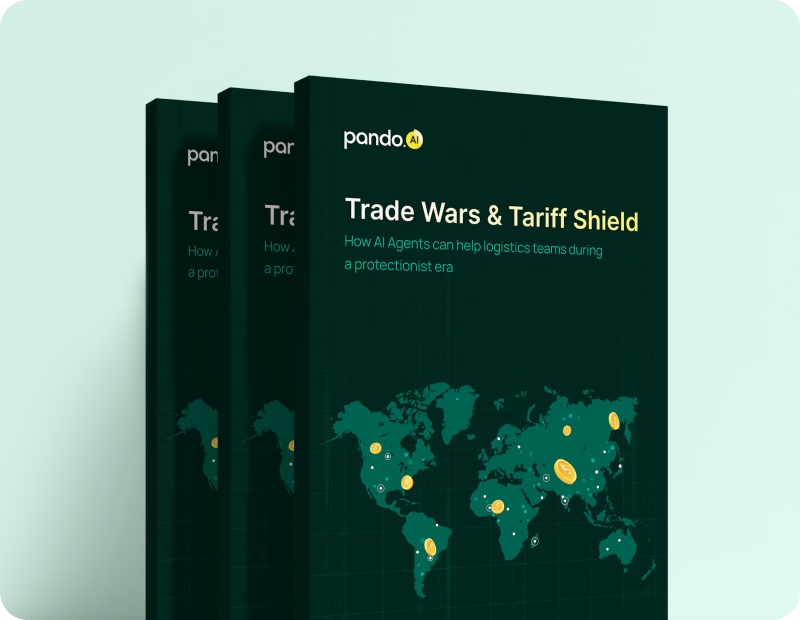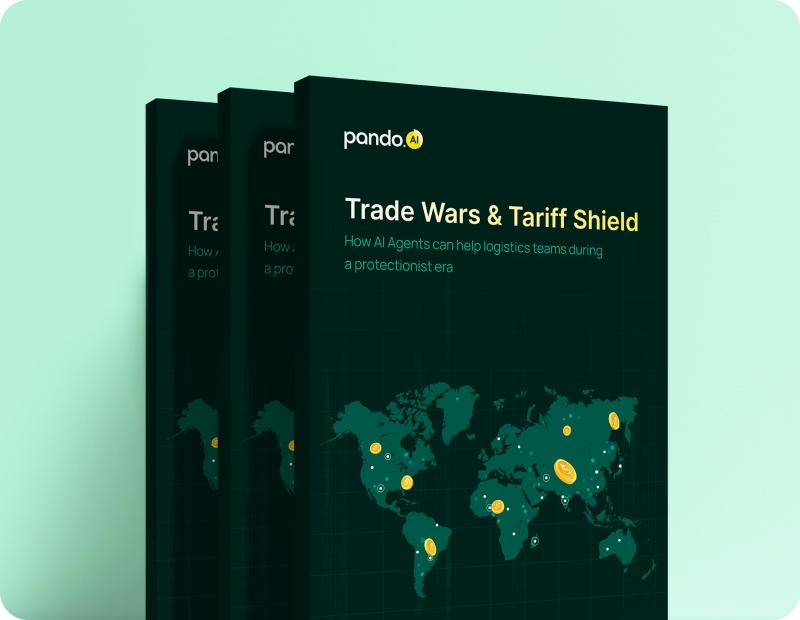-
Products Products
- Industry
- Initiatives
- Resources
- Company
- Book a demo

Before you go: Logistics leaders just dropped the truth on AI
The State of AI in Logistics 2025 is here — no hype, just real conversations and raw insights.
Building a business case to invest in Transportation Management System – Part 2
Unveiling the final blueprint: Navigating risks, challenges, vendor evaluation, and ideal project frameworks for TMS implementation success.
Published on January 31, 2024 • 7 mins read
Ganesh Iyer

Unveiling the final blueprint: Navigating risks, challenges, vendor evaluation, and ideal project frameworks for TMS implementation success.
With the foundation laid for strategic decision-making, our journey into the realm of TMS investment continues to unfold. In part 1 of our series, we dissected the key components essential for constructing a robust business case, focused on measuring the Return on Investment (ROI) of implementing a TMS. Now, in Part 2, we navigate through the intricate terrain of risk and challenges, conduct a comprehensive vendor evaluation, and equip you with a powerful template for financial analysis. This ensures thorough preparation ahead of the TMS journey.
Identifying risks, challenges, and overcoming objections in your business case
Upgrading your legacy solution or implementing a new transportation Management System (TMS) is a strategic decision that holds the promise of improved efficiency and streamlined operations for your organization. Nevertheless, the journey towards TMS implementation is not devoid of challenges. Recognizing and comprehending these challenges is not merely a preparatory measure; it is an essential strategic imperative aimed at guaranteeing a successful and seamless transition. Let's explore the reasons why recognizing these potential obstacles is of paramount importance:
ROI uncertainty: Calculating the Return on Investment (ROI) for a TMS is a complex undertaking, setting the stage for a collaborative effort between your business and TMS vendors. This dynamic process involves your active involvement in detailed dialogues with TMS vendors. Utilize historical data and industry benchmarks to gauge the expected impact, incorporating conservative, most likely, and optimistic estimates. Recognize that ROI calculations are not a one-time affair; continuous monitoring and refinement throughout the implementation process are essential for adapting strategies based on real-time data and evolving business dynamics, ensuring the accuracy of your ROI projections.
Resistance to change: You understand that human nature tends to resist change, and introducing a new technology, like a TMS, can be met with initial hesitation. Your employees, familiar with existing processes, might balk at the learning curve associated with the TMS. To strategically overcome this, implement targeted training programs tailored to your workforce's needs. Provide training templates and downloadable resources, empowering your team to navigate the TMS adoption confidently. Emphasize not only the organizational benefits but also the long-term advantages for individual employees, bridging the gap between their current comfort zone and the positive impact the TMS can bring to their daily tasks and professional growth. Share success stories, especially those of change champions who initially resisted but later embraced the TMS, creating a relatable narrative that fosters acceptance and engagement by showcasing tangible personal and professional benefits. Please ensure to have your TMS Vendor as your partner to drive organization adoption and consistently measure adoption metrics.
Budget constraints: Financial prudence will always be a critical consideration for businesses. The upfront costs associated with TMS implementation might raise eyebrows among decision-makers, especially when tech investments are continually scrutinized for financial benefits. Instead of perceiving budget constraints as a roadblock, see them as a pivotal moment that urges you to conduct a comprehensive cost-benefit analysis. Move beyond mere numbers to vividly showcase the potential savings and operational enhancements promised by the TMS. Utilize a cost-benefit calculator to visualize potential savings and ROI with your specific data. Exploring flexible payment models with TMS vendors, whether through subscription-based or pay-as-you-go arrangements, is a strategic move. This flexibility aligns the financial commitment with your organization's budgetary constraints, making the adoption more feasible.
Integration complexity: Integrating a TMS with existing systems transcends being a mere challenge; it carries potential repercussions such as downtime, cost overruns, or missed opportunities, which could adversely impact operational efficiency and overall productivity. It is imperative to quantify this risk, and a self-assessment or checklist can help gauge the intricacies of your IT infrastructure, providing a structured approach to identifying potential bottlenecks and ensuring a smooth integration process. Real-world success stories, such as a case study showcasing a seamless transition with a TMS provider, emphasize the significance of strategic partnerships and highlight the transformative impact that meticulous planning and collaboration can have on the success of TMS adoption.
Data security and protection: Choose a TMS provider with robust security measures, scrutinizing encryption protocols and compliance standards. Define user roles following the "need-to-know" principle, limiting sensitive data access. Integrate encrypted channels for secure data transfer between TMS and ERP systems, fortifying operations' integrity. Conduct frequent security reviews, addressing vulnerabilities swiftly to bolster system resilience. By taking proactive steps, instill confidence in the continual safeguarding of your data assets.
Vendor evaluation criteria for your TMS: A quick guide
When selecting a TMS vendor, it's crucial to cut through the noise and focus on key criteria that align with your specific needs. Here's a to-the-point guide to help you evaluate vendors effectively:
 Refer to our in-depth blog series, "Top 10 things to consider when choosing a TMS - Part 1 and 2," to gain a more profound insight into each criterion and make an informed decision to propel your supply chain efficiency. Your TMS should not just be a tool; it should be a strategic solution tailored to your industry-specific challenges.
Refer to our in-depth blog series, "Top 10 things to consider when choosing a TMS - Part 1 and 2," to gain a more profound insight into each criterion and make an informed decision to propel your supply chain efficiency. Your TMS should not just be a tool; it should be a strategic solution tailored to your industry-specific challenges.
An ideal template for project success
In this section of the blog, we'll delve into a comprehensive framework template that outlines key aspects of a strategic approach to build a business case for TMS investment. As you navigate through this framework, you'll gain insights into each crucial component, shaping a roadmap for an effective solution. To delve deeper into each section, access our comprehensive template for a more thorough understanding – available for free download.
Executive summary: Begin with a concise overview of the current situation, highlighting key goals such as the freight spend, legacy TMS limitations, and existing challenges.
Current situation: Provide an overview of your current freight operations to give your leadership insight into the existing state. This understanding acts as a reference point for comparison with the envisioned future state.
- Freight spend: Unpack the intricacies of your current freight spend, shedding light on the financial implications. Understand the pain points and inefficiencies that necessitate a paradigm shift.
- Legacy TMS limitations: Articulate the constraints posed by your existing Transportation Management System. Identify the bottlenecks hindering operational efficiency and explore the scope for improvement.
- Challenges: Detail the broader challenges your organization faces in the realm of freight management. This could include anything from scalability issues to rising freight costs to lack of visibility to carrier relationships to compliance concerns.
Proposed solution: Introduce the transformative solution and shed light on the vendor selection process. Quantify the benefits, including cost reduction and productivity improvements, as a contrast to the challenges faced in the present.
- Highlight the new solution: Introduce the proposed solution that promises to revolutionize your freight management. Additionally, provide insights into the vendor selection criteria and the thorough evaluation process undertaken.
- Quantify the benefits: Break down the anticipated benefits of the new solution. Delve into cost reduction measures, productivity improvements (measured in man-hours saved), enhanced customer experience (CX), and the positive impact on the environment through CO2 emissions reduction.
- Implementation plan: Outline the roadmap for implementing the new solution. Provide a timeline, budget, and resource allocation plan. This section serves as a practical guide for your organization's transition.
Financial impact analysis: Break down the financial aspects, detailing investment costs and calculating ROI. This contrasts the current abstract notion of change with measurable metrics, allowing stakeholders to understand the financial commitment and expected returns.
- Investment: Break down the financial implications, including software license fees and implementation costs. This section prepares your stakeholders for the financial commitment required.
- ROI: Quantify the Return on Investment (ROI) in percentage terms. Additionally, calculate the pay-back period, giving stakeholders a clear understanding of when they can expect to recoup their investment.
Risk mitigation plan: Navigate potential challenges with a robust risk mitigation plan. Present the IT systems architecture and a phased implementation strategy as a proactive approach, in stark contrast to the current situation's uncertainties.
1. IT systems architecture and integrations: Outline the blueprint of your IT systems and illustrate seamless integrations for a streamlined technological landscape.
- Lay out the IT systems architecture: Provide a detailed blueprint of the proposed IT infrastructure. This should include how different systems will be interconnected and the overall architecture that supports the new solution.
- Integration strategy: Clearly define how the new solution will integrate with existing systems. Specify the protocols, APIs, or middleware that will facilitate seamless data flow between different components.
2. Phased implementation: Implement changes strategically in phases, contrasting with the current all-encompassing approach for a smoother transition.
- Scope the project: Define the scope of the project by breaking it down into manageable phases. Consider structuring the implementation based on movements, business units, or modules.
- Primary and secondary phases: Clearly outline the primary and secondary phases of the implementation. This might involve prioritizing certain aspects or functionalities over others based on critical business needs.
- Industry segmentation: If applicable, segment the implementation based on industries or sectors such as Appliances, FMCG, or Textile. Tailor the approach to the specific requirements and nuances of each industry.
- Functional segmentation: Break down the implementation further by focusing on specific functions such as Freight Audit and Payment, TMS, and Freight Procurement. This modular approach allows for a more organized and controlled rollout. Check out this video where Neha Parekh, Director of Supply Chain at Nivea, elaborates on the benefits of a modular approach and how it aligns with key requirements such as easy integration, scalability, and a model-by-model subscription.
Stakeholders involved and their feedback: Highlight the key stakeholders involved in this transformative journey. Gather and present their feedback, ensuring transparency and a collaborative approach to the freight management transformation.
From insights to action: A roadmap to TMS success
In our comprehensive two-part guide, encompassing both Part 1 and Part 2, we've meticulously covered the critical aspects of building a business case to invest in TMS. Part 1 laid the foundation by exploring the significance of TMS and initiating the construction of a compelling business case. Part 2 expanded on this groundwork, addressing the intricacies of identifying and overcoming risks and challenges. From the nuances of vendor evaluation criteria to the elucidation of an ideal project success framework, you now possess a holistic understanding of TMS implementation.
As you embark on this transformative journey, consider this guide your strategic compass. Let every challenge become an opportunity and allow the outlined strategies to lead you toward a successful and measurable ROI. Your path is illuminated; it's time to make informed decisions and witness the transformation of challenges into opportunities for business growth and efficiency.
Subscribe to Pando blog and Crossroads newsletter now!
Stay up to date with the latest logistics, transportation, and supply chain tips and news.
Subscribe Here!

Related blogs
Building a business case to invest in Transportation Management System – Part 1

Top 10 things to consider when choosing a transport management system – Part 1











